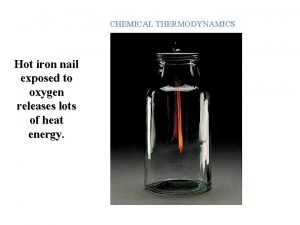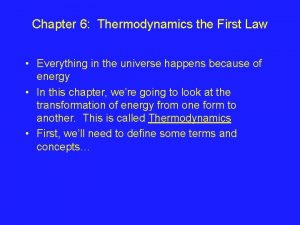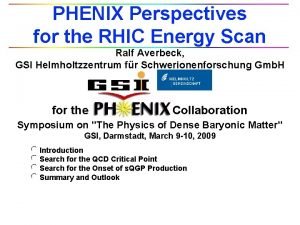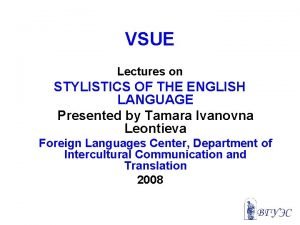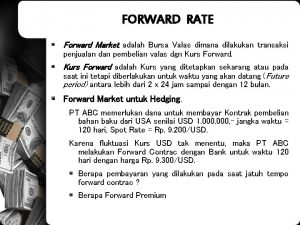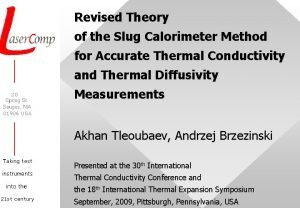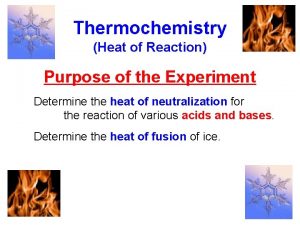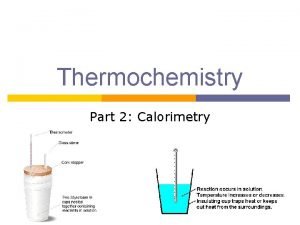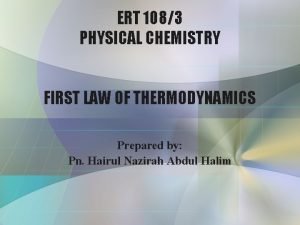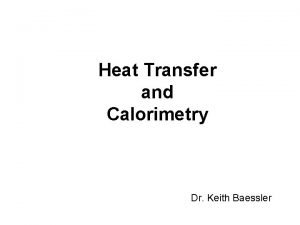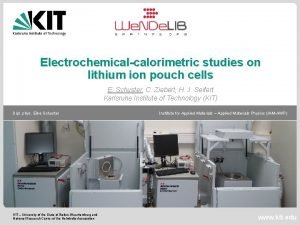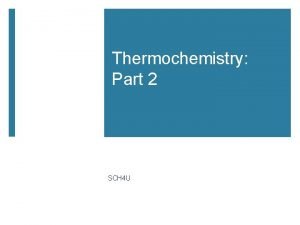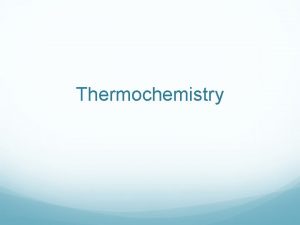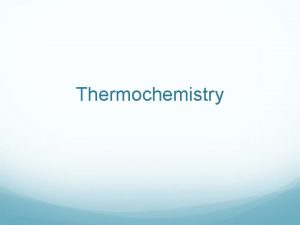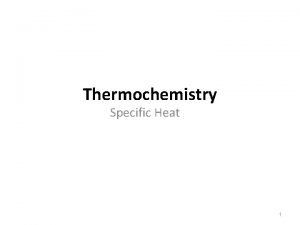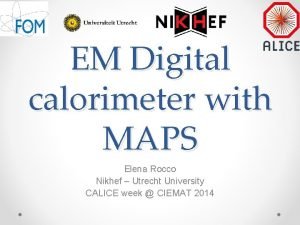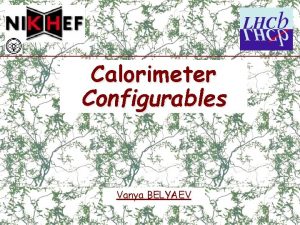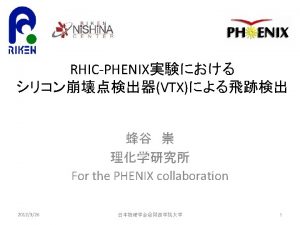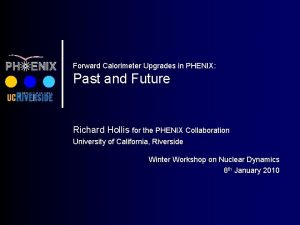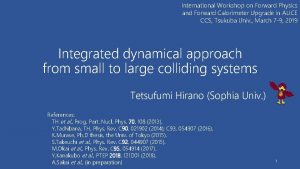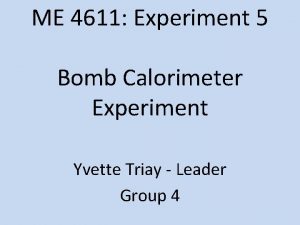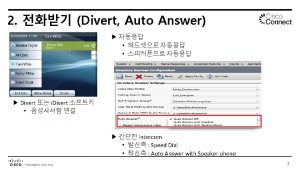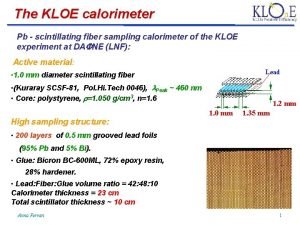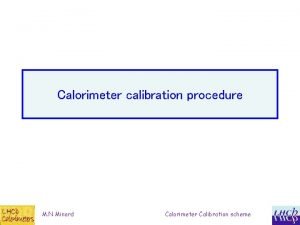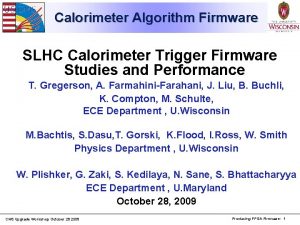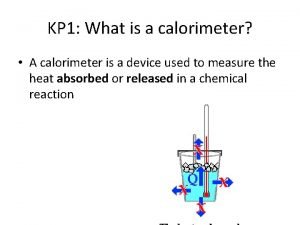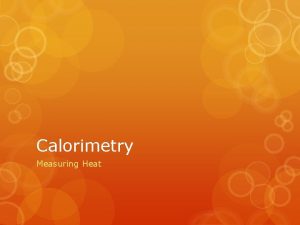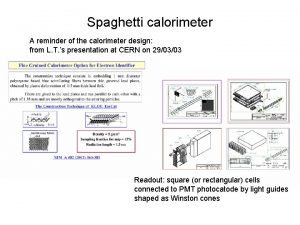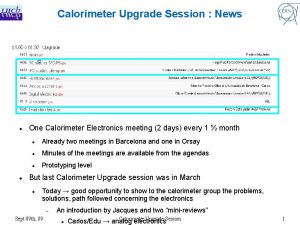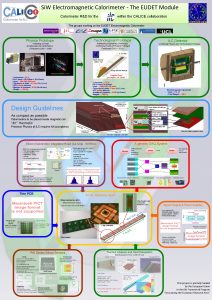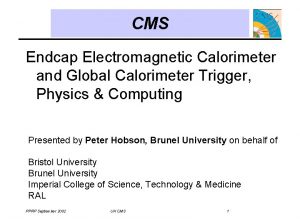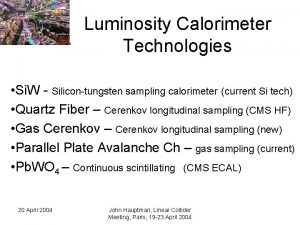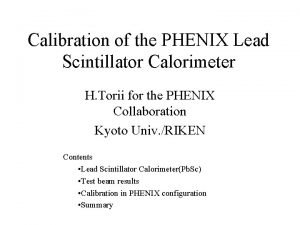A FOrward CALorimeter for the PHENIX experiment Y























- Slides: 23

A FOrward CALorimeter for the PHENIX experiment Y. Kwon Yonsei Univ. Korean FOCAL group Chonbuk National Univ. , Ewha Woman’s Univ. , Korea Univ. , Myungji Univ. , Yonsei Univ.

PHENIX Optimized for Rare probes e, , , high p. T hadrons Collision location

Fo. CAL & PHENIX : Focus on rare processes limited rate Luminousity limited acceptance Upgrade? Fo. CAL : Forward upgrade, A high density, high granularity Si-W tracking calorimeter.

Acceptance 2 coverage in azimuth and 0. 9 < h < 3. 0 Technically, EMCal Focus on Ability to distinguish between photons and π0’s up to 60 Ge. V Ability to identify EM/hadronic activity

When e/ enters material…

Detector Design Scheme Pad layer uses 4 mm W and 535 m silicon sensors. Spatial restrictions Compact detector, ~ 20 cm depth with high granularity 0 High resolution xy silicon strip layers for γ/π Small Moli’ere radius ~ 14 mm. discrimination Si-W supertowers stacked in brick-like manner.

Resolution

0 reconstruction

Beam test 2007 ü ADC mean value shows linear dependence on incident electron energy high density, high granularity Close to simulation result 100 Ge. V e width 5% 9

A native picture FOCal would allow us to study the medium via long range correlations. FOCAL will extend h reach, Dh ~ 5.

Under study Parameterized background by studying average energy deposited in the detector (E) and its fluctuations (RMS).

NSAC milestones Year # Mile. Stone FOCAL 2012 DM 8 Determine gluon densities at low x in cold nuclei via p+ Au or d + Au collisions. Required for direct photon 2013 HP 12 Utilize polarized proton collisions at center of mass energies of 200 and 500 Ge. V, in combination with global QCD analyses, to determine if gluons have appreciable polarization over any range of momentum fraction between 1 and 30% of the momentum of a polarized proton. Low-x Direct 2014 DM 10 (new) Measure jet and photon production and their correlations in A≈200 ion+ion collisions at energies from medium RHIC energies to the highest achievable energies at LHC. DM 10 captures efforts to measure jet correlations over a span of energies at RHIC and a new program using the CERN Large Hadron Collider and its ALICE, ATLAS and CMS detectors. Marginal without FOCAL 2015 HP 13 (new) Test unique QCD predictions for relation between single-transverse spin phenomena in p-p scattering and those observed in deep-inelastic lepton scattering. New theoretical breakthroughs of recent years in understanding the parton distribution functions accessed in spin asymmetries for hard-scattering reactions involving a transversely polarized proton Required

Another motivation

D-Ram? CPU? Si-detector?


ETRI

Really competitive? ¢ Cost (10 3)$/cm 2 is typically quoted price. p 5$/cm 2 or so for ETRI processing… probably lower side. Cost includes p § yields p ¢ and fabrication capability ( good infra-structure ). PHENIX FOCAL plans to purchase from Korea if … (already helped R&D by about 30 k$ ). Future p Cost for nano. FAB will be even lower… It will remain to be so for a while.

Silicon pad sensor • Basically • N-type • 16 PN junction diode in reverse bias mode. substrate and p-type pattern for high energy application => electrons are carriers square(1. 5 cm× 1. 5 cm) pads in one micro-module - ground Yonsei Nuclear Physics Lab. 18

Production results • 4 sample micro-module production has completed. • Mechanical and electrical issues have been checked Yonsei Nuclear Physics Lab. 19


Preamp Card

Preamp Card Output signal Injected signal

Summary • Explored FOCAL acceptance ~ 0. 9 <η <3. 0 • FOCAL will trigger, detect, and identify e, , and 0. • energy resolution ~ 5% at p = 25 Ge. V/c or p. T ~ 10 Ge. V/c. • Technically, W/Si calorimeter • High density, high granularity. • Replacing existing auxiliary absorbers in the muon spectrometers. • Test beam scheduled at CERN and assisted by ALICE. • Evaluation by full simulation in progress. • Korean groups are marching aggressively. • Sensor production & test • Readout ( preamps ) • We plan on having FOCAL fully installed and operational by 2012.
 Calorimeter problems
Calorimeter problems Coffee cup calorimeter formula
Coffee cup calorimeter formula Coffee cup calorimeter vs bomb calorimeter
Coffee cup calorimeter vs bomb calorimeter Professional and social jargonisms
Professional and social jargonisms Phenix scan
Phenix scan Scan trip
Scan trip Jargonisms
Jargonisms Forward market adalah
Forward market adalah Currency forward market
Currency forward market Slug calorimeter
Slug calorimeter Unit of bmr
Unit of bmr Bomb calorimeter uses
Bomb calorimeter uses Combustion reaction
Combustion reaction Function of bomb calorimeter
Function of bomb calorimeter Calorimeter
Calorimeter Calorimeter
Calorimeter Accelerating rate calorimeter
Accelerating rate calorimeter 62g
62g Identify what a bomb calorimeter measures
Identify what a bomb calorimeter measures Calorimeter
Calorimeter Specific heat equation units
Specific heat equation units The seven forms of energy
The seven forms of energy Digital calorimeter
Digital calorimeter Coffee cup calorimeter
Coffee cup calorimeter

